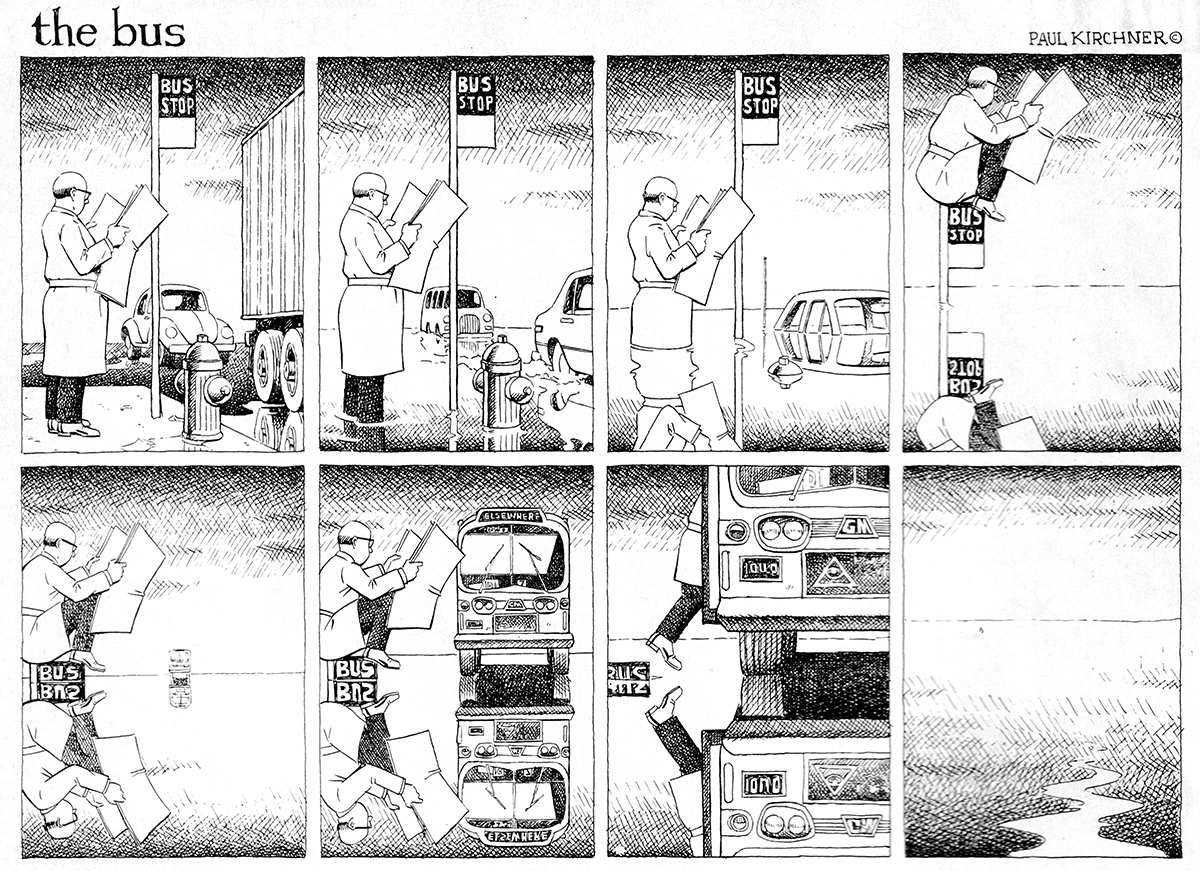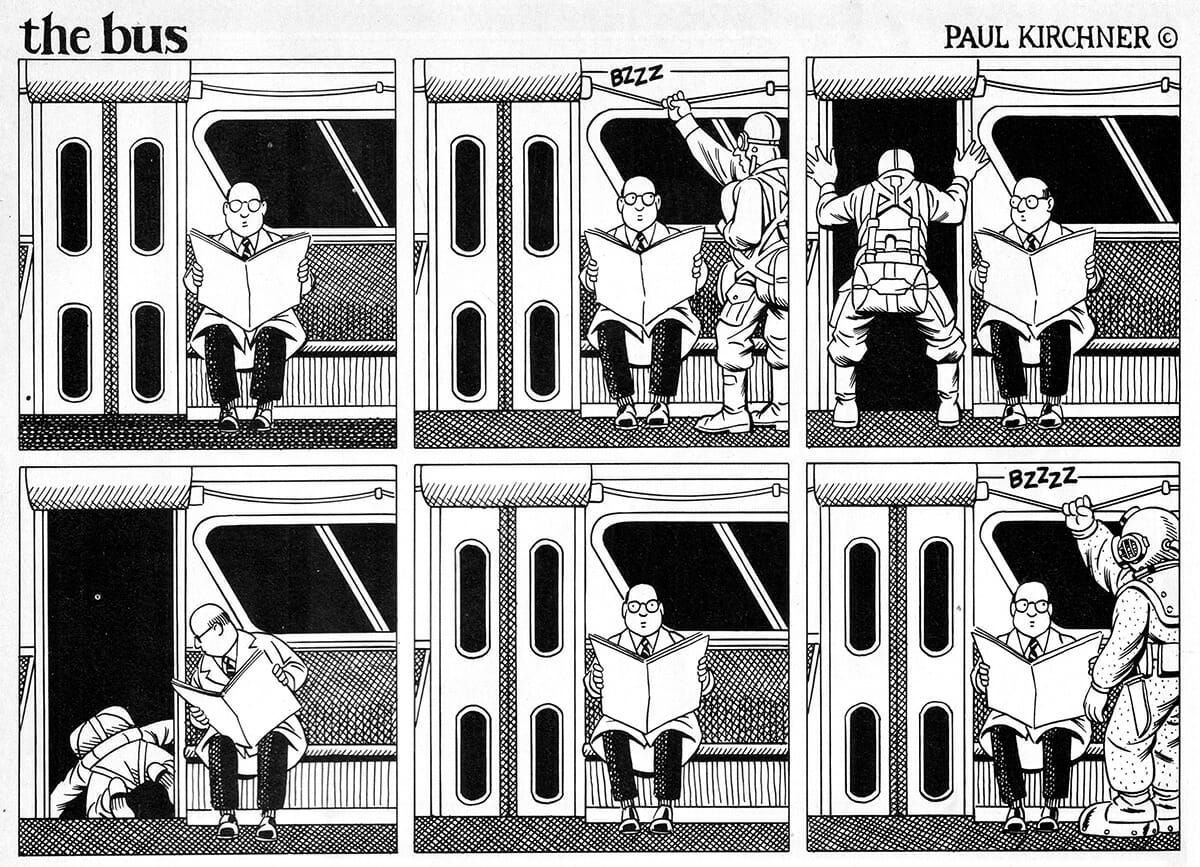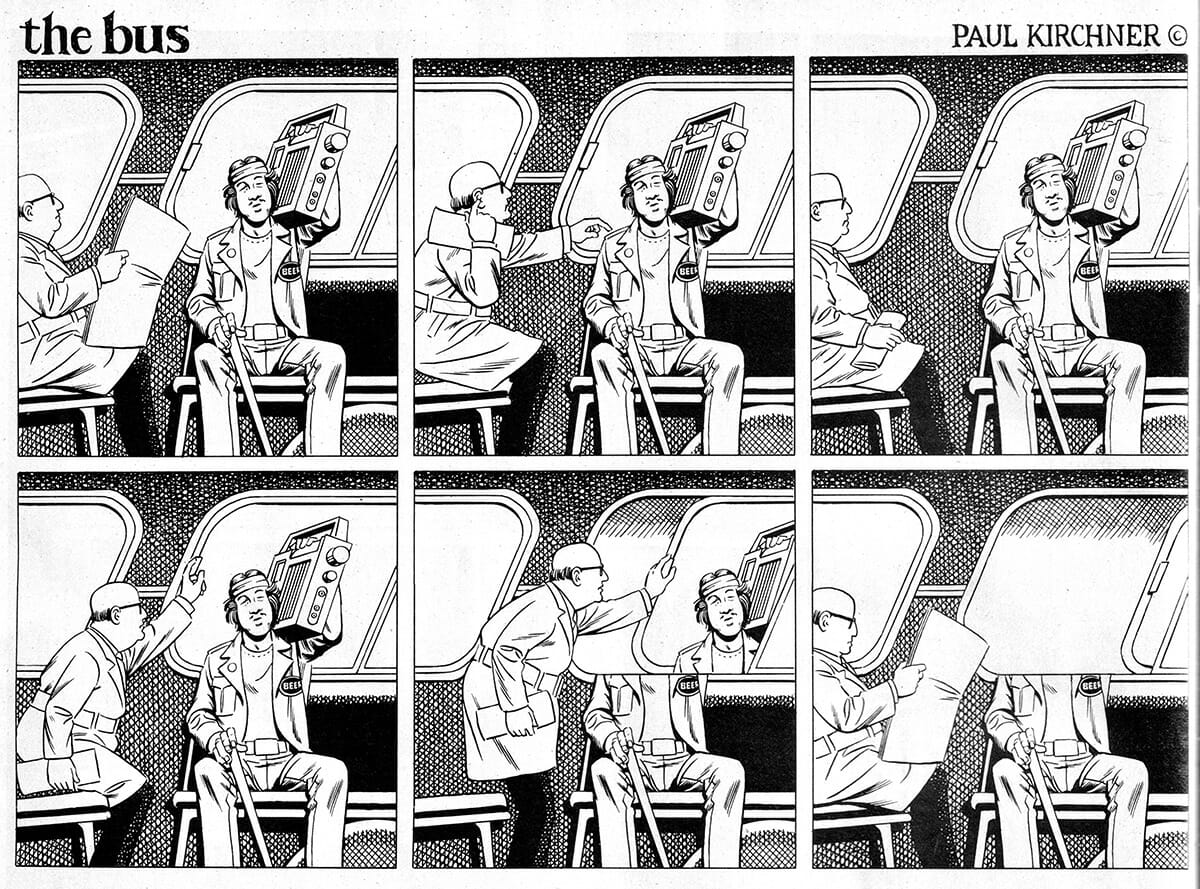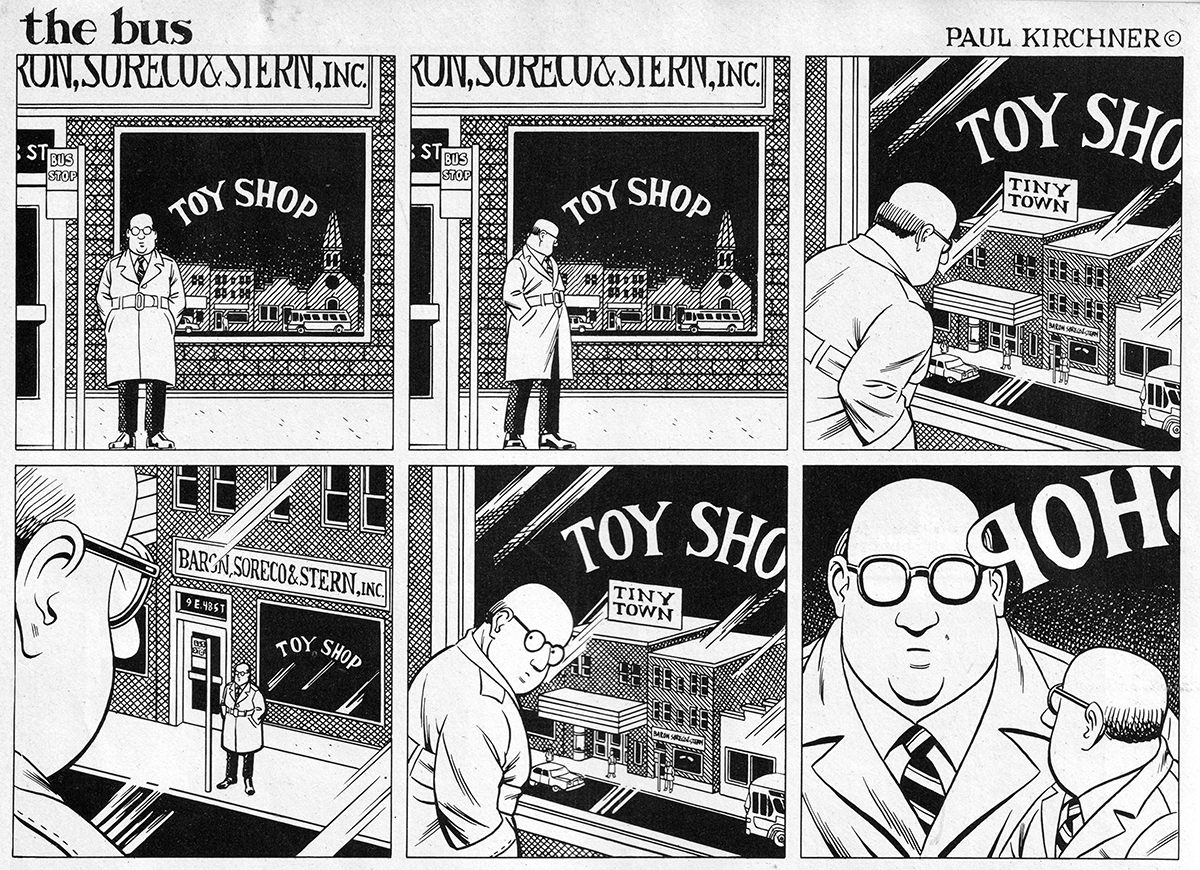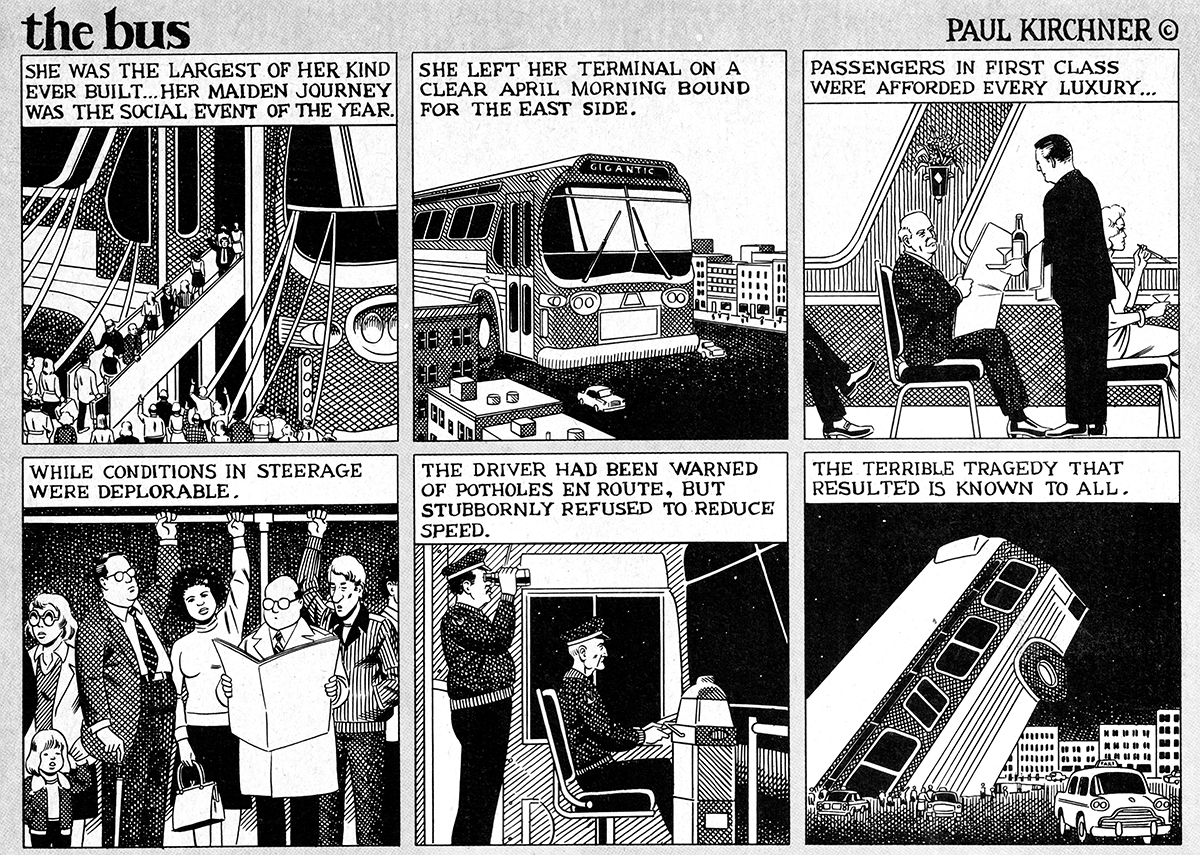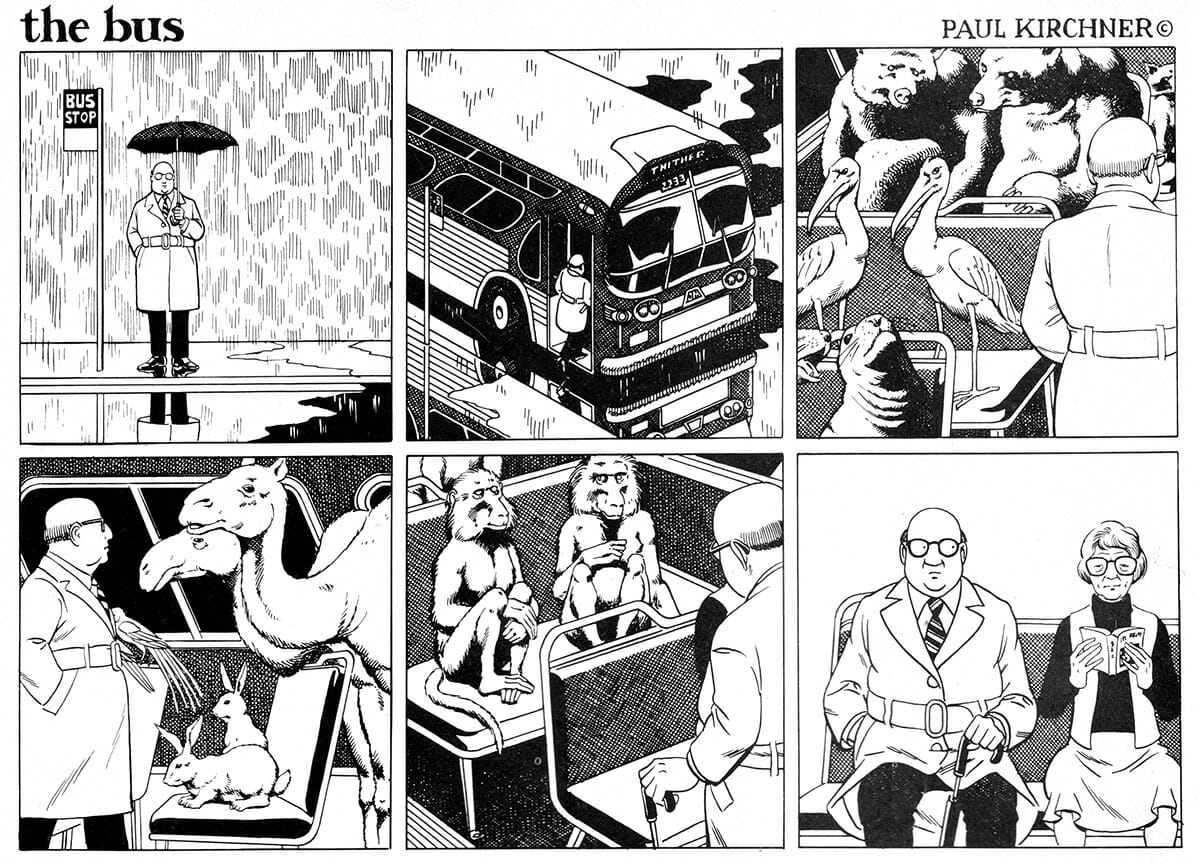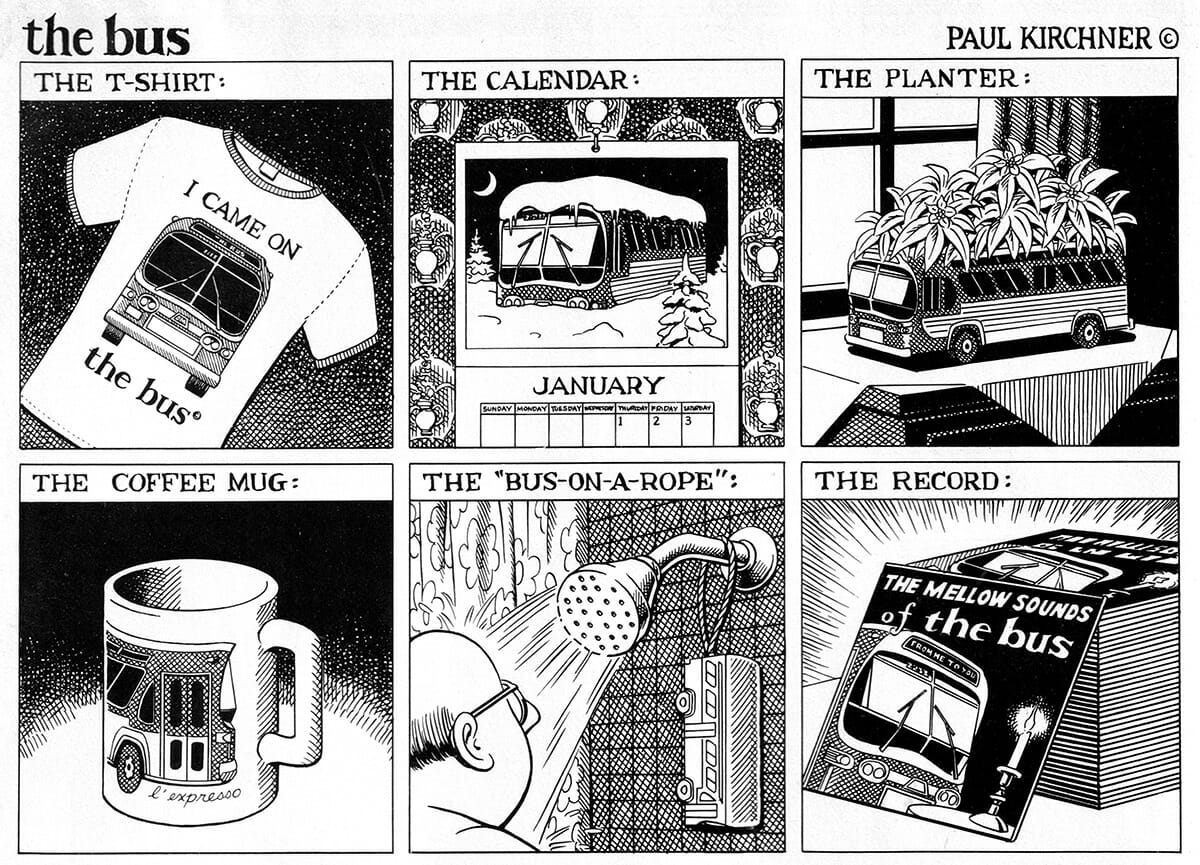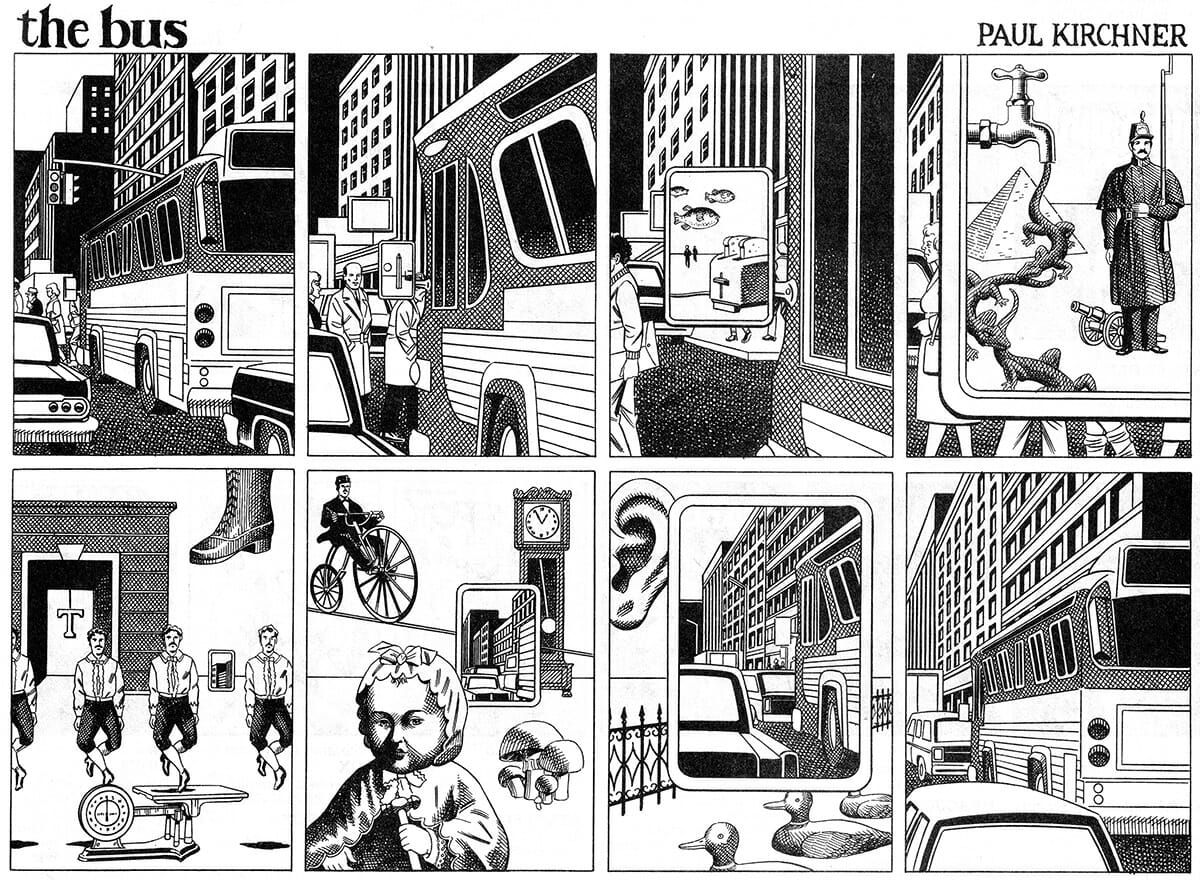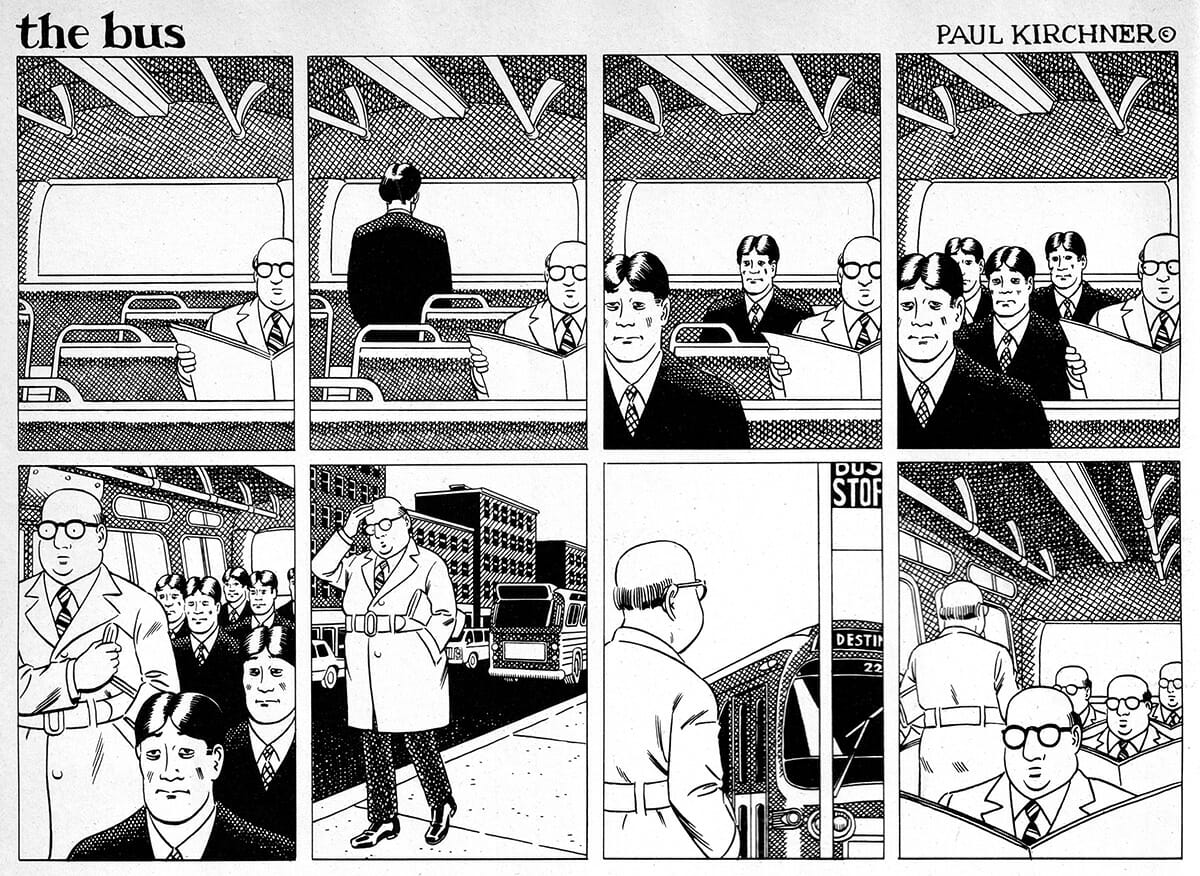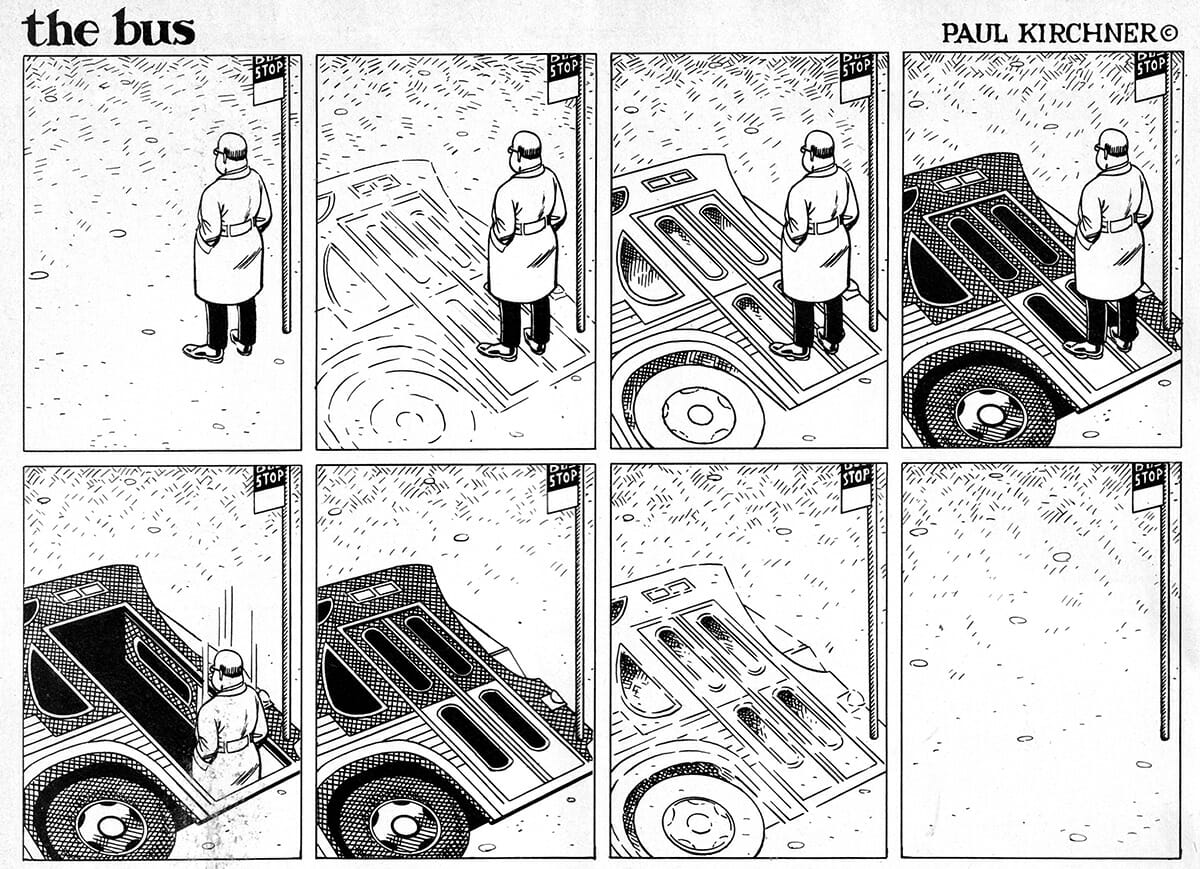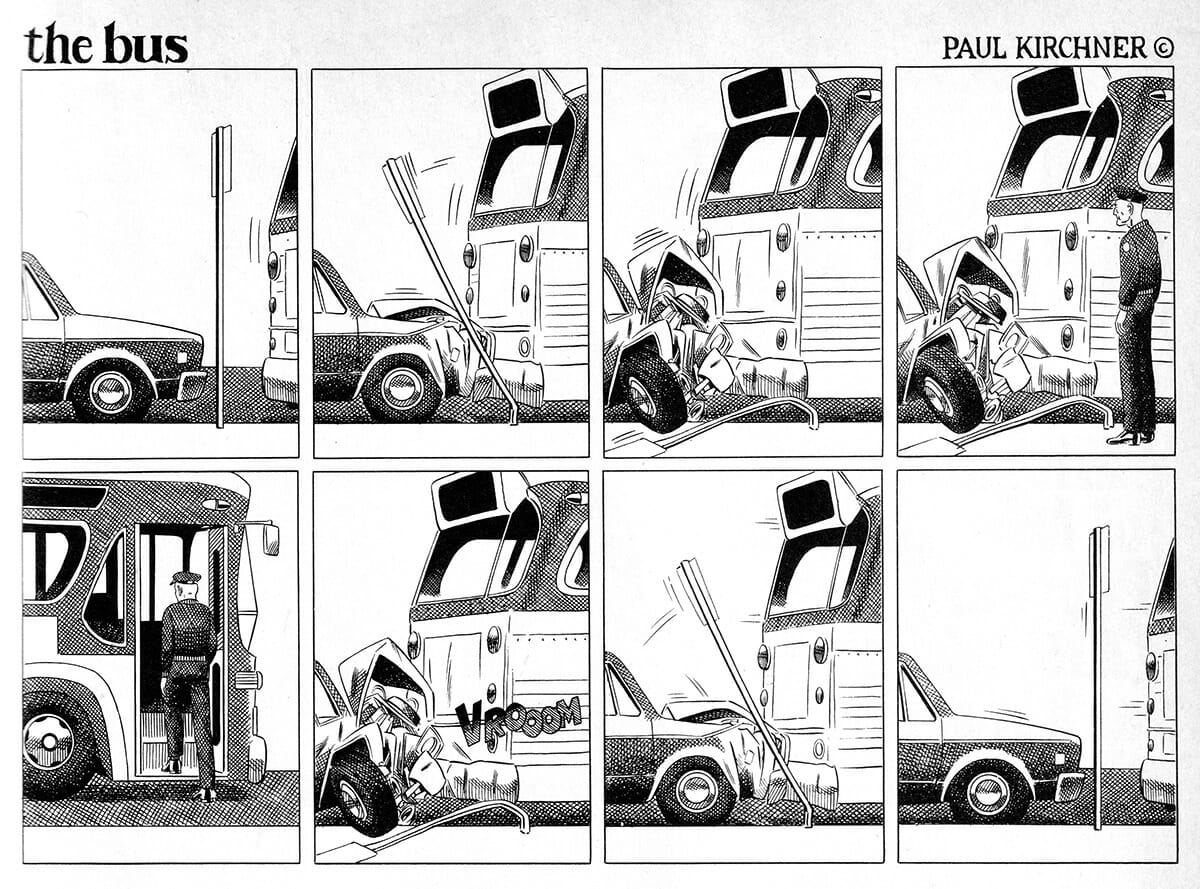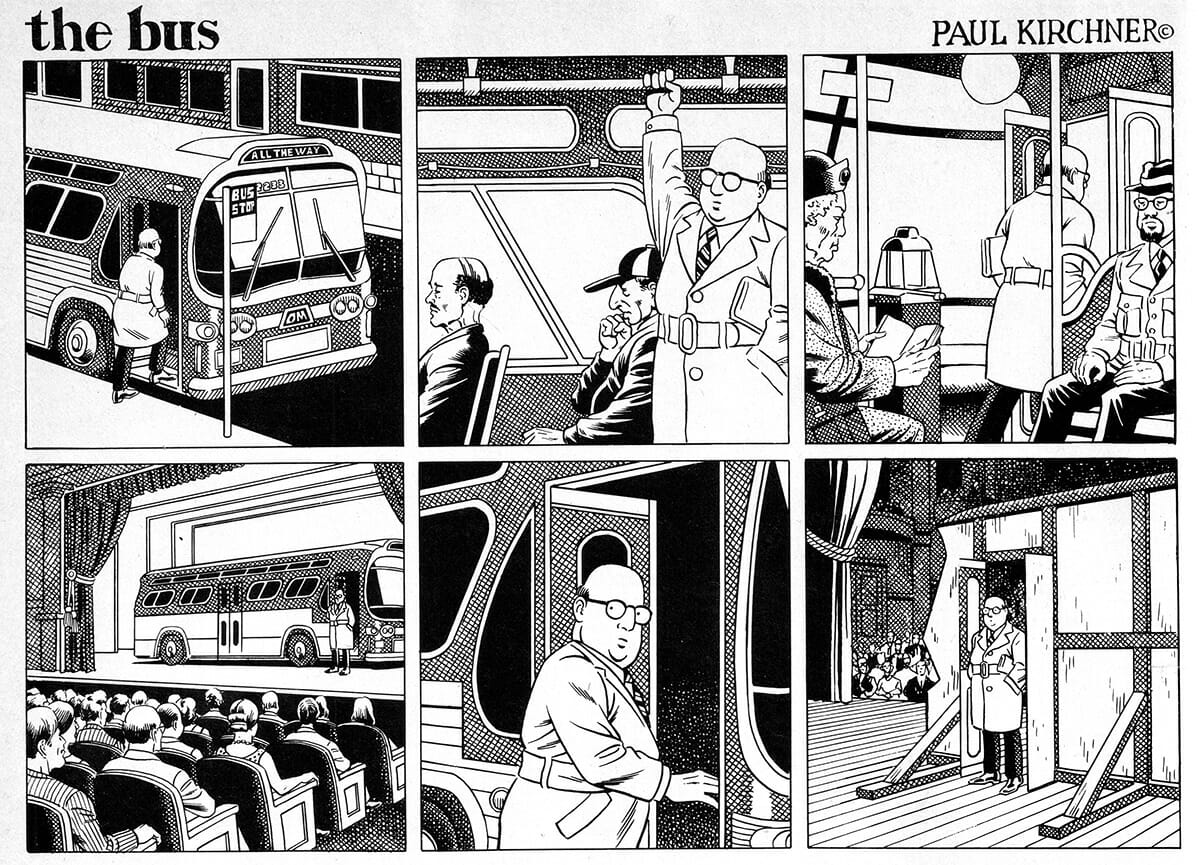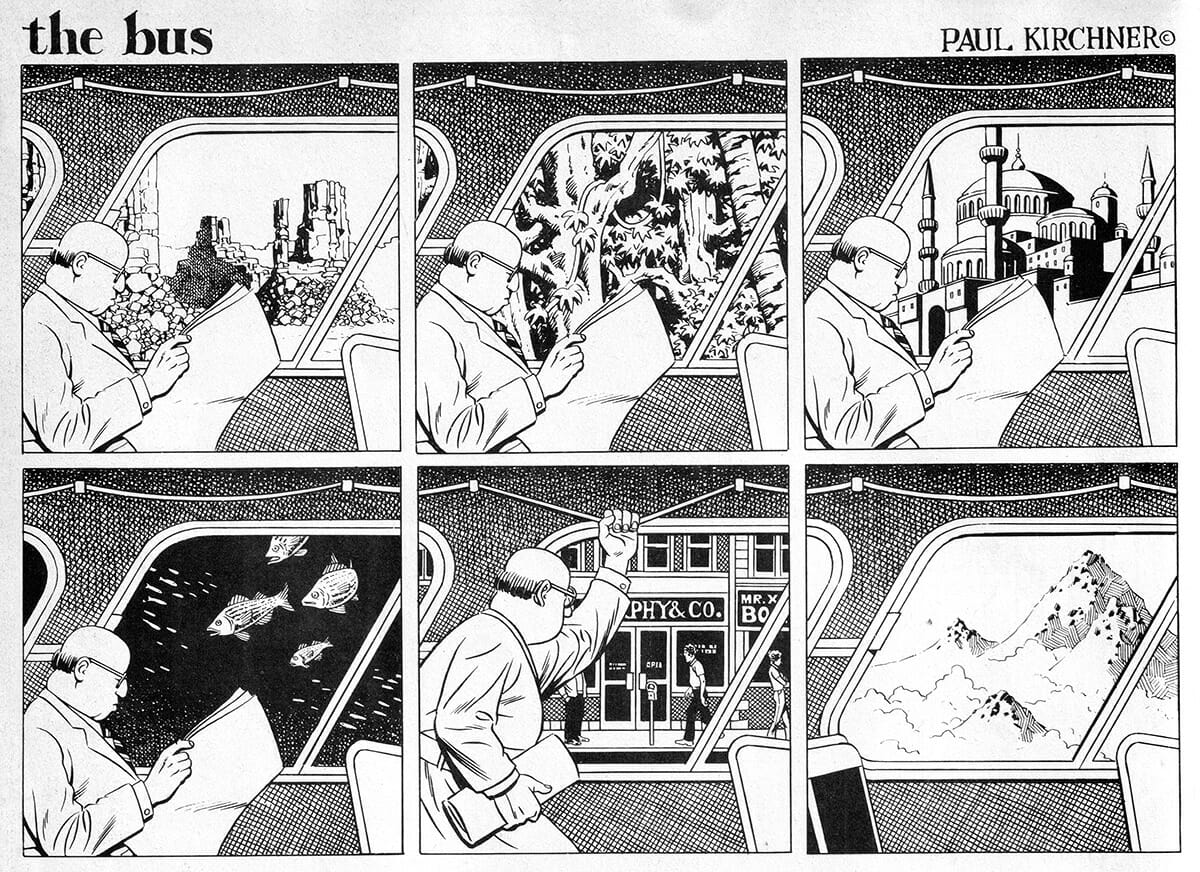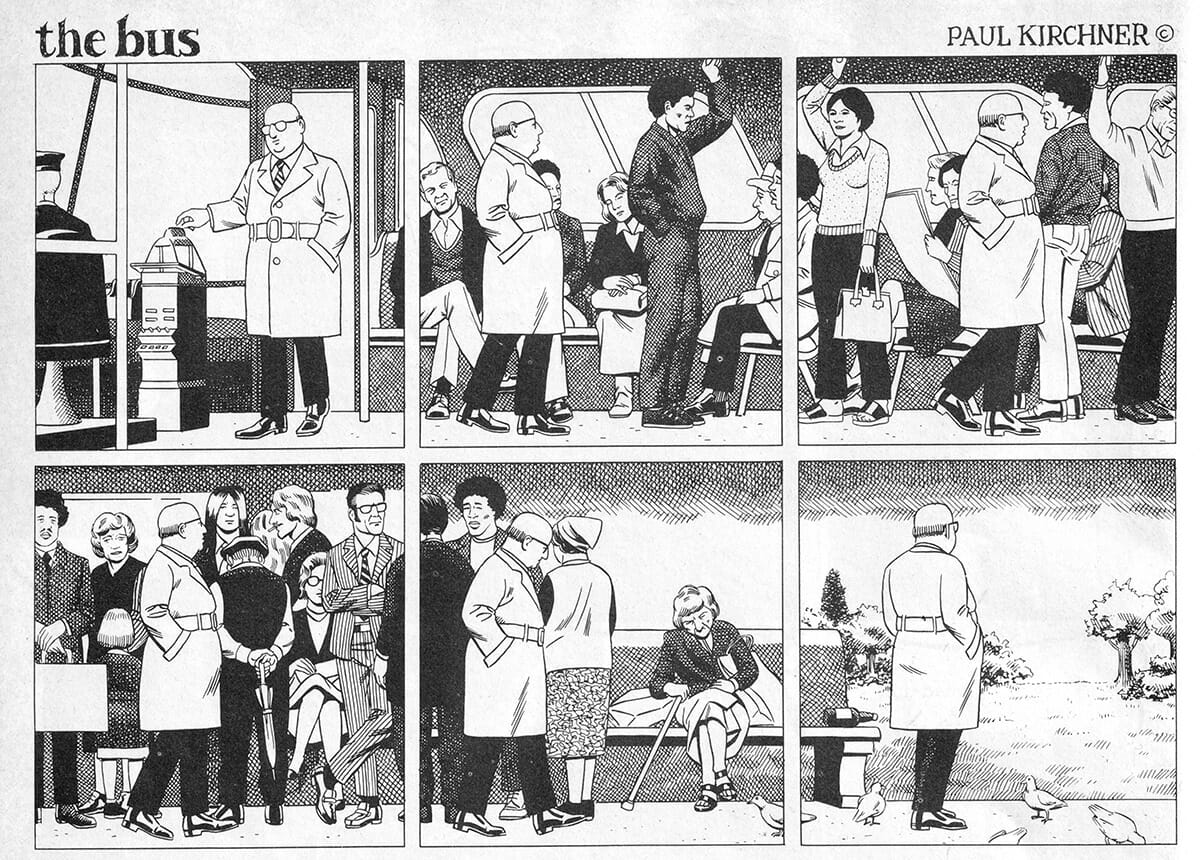Two decades later, I borrowed the magazines from my father and started a second reread. I had a better understanding of the material that I was looking at, I decided. I now knew who Jacques Tardi was, for example, and could appreciate why it was interesting to find a story by him in an issue from 1977. When I got to the first appearance of The Bus in the January 1979 issue, I was nervous. Could my memory be trusted? My tastes had changed significantly in the interval – I had long since given up the superhero comics that were a mainstay of my teenage years. What if The Bus wasn’t good the second time around? Reader: the strip holds up.
The Bus is a black and white half page strip about an unnamed man who rides a bus. He’s always dressed in an overcoat over a suit, is bald, wears glasses. In later material, he’s referenced as “The Commuter”, but never during the initial Heavy Metal run. In fact, the entire strip is without word balloons or sound effects — with only the occasional signs and some of the meta strips featuring captions — but the vast majority of the strip relies entirely on old-fashioned cartooning and sequential storytelling.
The everyman commuter is the heart of the piece, providing a point of view for readers with his minimalist reactions to the surreal and absurd things happening around him. It often feels like he’s asking himself if he got on the right bus (and, in one instance, that’s actually the punchline). He provides the foundation that best allows The Bus to highlight how taking the bus under ordinary circumstances can sometimes be transformed from a banal event into something very weird. The Bus takes that transformation and turns it up to eleven. The commuter is given no explanations for what he encounters and neither is the reader. The unwillingness to explain puts the onus on the reader and makes the strip feel more mature as a result.
Paul Kirchner, was well-established as a comics creator by the time he began working on The Bus. He had spent time as an assistant for Wally Wood, but was best known for readers of High Times for his Dope Rider strip–a lushly illustrated phantasmagoria about a skeleton that smokes marijuana. To the New York illustration community, he was known as the guy whose work showed up on the cover of weekly magazine Screw twice a month in the mid-70s under the name Kurt Schnurr. The Bus, however, was the output of a seasoned creator who no longer needed to prove anything to anyone but was instead just having fun.
Unlike the earlier material, The Bus is stripped down – no color, just ink and zip-a-tone. It was not a simple strip, but it was elegant with much of the detail leaning more towards realism than not. At the same time, only the important details are retained, with an obvious considerable effort put into explaining the spatial relationships between the various vehicles and the characters that inhabit the page.
The strips can be roughly broken into three broad groupings. The first, which make up the majority of the strip’s run — are ones with focus on the everyman commuter. Then there are the strips that are formalistic experiments, mostly featuring the bus interacting with its environment. The final group are meta commentaries on the bus as a cultural phenomenon. In all cases, the strip is a celebration of the voyeuristic impulses that arise naturally from spending time around complete strangers.
Because the strip is only half a page, these experiments tend to be one-note, a sharp, straightforward examination of a single idea. The cleverness of the execution keeps them from being simple or boring. For the best of them, it would take longer to explain the idea that the strip conveys than it would to just look at it and take it in.
The meta strips are droll and basically swap the bus into examples of popular culture from the early 80s. They are very often commentaries on the absurdity of popular culture and posit that anything can be popular if marketed correctly – which is very prescient for the time. However, these strips rely heavily on captions instead of cartooning. As a result, these strips feel clumsier and more diffuse precisely because they explain with words instead of trusting the art and the reader.
The sixty-eight issues that the strip has appeared in makes The Bus the longest running strip that’s ever been printed in Heavy Metal. It ran almost monthly from 1979 right through to the point where Heavy Metal went quarterly in 1986 and completely changed their publishing strategy, dropping all of their legacy strips in the process.
At the time that these strips were made, Heavy Metal had cultivated a reputation as a deeply subversive publication that challenged a lot of things about mainstream American comics. If nothing else, it proved that one could be commercially successful with an anthology magazine that featured sex, drugs, science fiction, and violence – all things that ran counter to the Comics Code.
Kirchner’s previous material leaned into the nature of the magazines they were produced for. Dope Rider was about smoking pot in a magazine dedicated to smoking pot. His work for Screw was raunchy. His best-known works prior to The Bus were all about sex and drugs, but The Bus did not feature sex, drugs, or violence. In fact, with its focus on the Commuter and the banality of the everyday commute, The Bus seemed to go entirely against the prevailing grain of Heavy Metal’s brand of over-the-top fantasy.
Despite their diverse audiences, Kirchner’s work for all three magazines share a certain surrealistic sensibility and sense of playfulness. But at the same time, Kirchner was an outsider to the drug cultures he catered to – he is famous for never getting high or taking hallucinogens. He just had the amazing ability to draw so realistically that the surrealism was grounded and, thus, more believable.
The fact that this particular little strip somehow managed to thrive despite its subject matter is fascinating. It probably shouldn’t be surprising, though. Heavy Metal’s approach to content has always varied wildly depending on the editorial staff, issue-to-issue dictates, and what often felt like whimsical choices. In many ways, the whole point of Heavy Metal is that the reader never really knows what any given issue is going to contain. If the material that Heavy Metal published did not already have such an eclectic range (both in terms of quality and artistic approach), I do not think that The Bus would have survived as long as it did.
Tanibis Editions published a collection of The Bus strips in 2014 that includes all of the strips that were originally printed in Heavy Metal. This is great news because now casual readers can pick up a single book instead of spending months or years digging through back issue bins in the quest to compile their own collection. I can casually hand a copy to a friend without worrying when I’m going to get it back – something I would not do with sixty eight issues of Heavy Metal from the early 80s.
On the other hand, the classic regret of archivists remains: the collection deprives the reader of the experience of reading it in its natural habitat. In the original issues of Heavy Metal, The Bus was often printed above advertisements, “coming soon” announcements, or other publication indicia and often towards the back of the magazine, making it feel like something hidden away in a back alley for dedicated readers who made it all the way through the issue. Of course it’s location was listed in the table of contents, but flipping through the magazine to find the individual strips gave the reader a sense of accomplishment. The content is the same in both experiences, but the reader’s experience of the rest of the magazine will influence their memory of the strip in subtle ways that the creator and publisher cannot possibly replicate.
In 2015, Tanibis Editions also published a second collection of brand-new strips called The Bus 2. Because the second collection was assembled directly to collection, it has a more notable overall coherence that the original, serialized strips lack. This is not the fault of the creator. On the contrary, it has everything to do with the format that Kirchner was creating for. By default, strips that were serialized over the course of six years are going to be less collectively coherent than something created explicitly to be collected. Especially since there was no expectation that the first batch of strips would ever be collected, much less twenty nine years after the last one was published.
If anything, the time away seems to have helped Kirchner stick the landing with his meta strips in the second collection, making them sharper and more polished. The collection starts with the meta-narrative concept that the original studio was shut down and the actor who portrayed the Commuter retired and has been replaced by his son. This sets up the rest of the book while simultaneously acknowledging the production gap in a way that takes advantage of the meta aspect of the strip. It is, like the rest of the strip, still very clever indeed.
